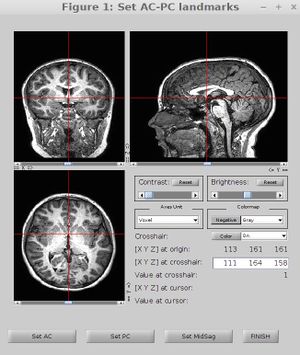Difference between revisions of "Anatomy Pipeline"
(→AC-PC Aligned Nifti Image) |
(→AC-PC Aligned Nifti Image) |
||
| Line 12: | Line 12: | ||
im = niftiRead(T1path); % Read root mean squared image | im = niftiRead(T1path); % Read root mean squared image | ||
voxres = diag(im.qto_xyz); % Get the voxel resolution of the image (mm) | voxres = diag(im.qto_xyz); % Get the voxel resolution of the image (mm) | ||
| − | mrAnatAverageAcpcNifti({T1path}, '/home/projects/anatomy/[subid]/t1_acpc.nii.gz', [], voxres(1:3)) | + | mrAnatAverageAcpcNifti({T1path}, '/home/projects/anatomy/[subid]/t1_acpc.nii.gz', [], voxres(1:3)) [[File:Ac-pc.jpg|300px|thumb|right]] |
| − | + | ||
==Freesurfer Segmentation== | ==Freesurfer Segmentation== | ||
Revision as of 18:08, 4 September 2015
We collect a high resolution T1-weighted image on every subject, and use this image to define the coordinate space for all subsequent analyses. This section describes the processing steps for a subject's T1-weighted anatomy and should be performed before analyzing the rest of their MRI data.
AC-PC Aligned Nifti Image
Data can come off the scanner with arbitrary header information and in parrec format. So for each subject we start by defining a coordinate frame where 0,0,0 is at the anterior commissure, the anterior and posterior commissure are in the same X and Z planes, and the mid-line is centered in the image. Bob Dougherty wrote a nice tool to help with this. See mrAnatAverageAcpcNifti. The subject's T1-weighted image should be ac-pc aligned, resliced (preserving its resolution), and saved in the subject's anatomy directory. Step 1: In a terminal, convert the PAR/REC files to nifti images
cd /home/projects/MRI/[subid] parrec2nii -c -b --scaling=fp *.PAR
Step 2: In MATLAB compute the root mean squared (RMS) image and then ac-pc align
T1path = 'Path to t1 weighted image'; T1path = mri_rms(T1path); % Root mean squared image im = niftiRead(T1path); % Read root mean squared image voxres = diag(im.qto_xyz); % Get the voxel resolution of the image (mm)mrAnatAverageAcpcNifti({T1path}, '/home/projects/anatomy/[subid]/t1_acpc.nii.gz', [], voxres(1:3))
Freesurfer Segmentation
Freesurfer is a useful tool for segmenting a T1-weighted image and building a cortical mesh. To segment the subject's T1-weighted image using freesurfer from the command line type:
recon-all -i /home/projects/anatomy/[subid]/t1_acpc_.nii.gz -subjid [subid] -all
Or even better use this handy matlab function written by Jon Winawer to run freesurfer and then also build some useful files that we like to use for data visualization such as a high resolution gray/white segmentation.
fs_autosegmentToITK([subid], '/home/projects/anatomy/[subid]/t1_acpc_.nii.gz')
Preprocess diffusion data
If diffusion data was acquired on the subject we want to (a) correct for EPI distortions in the data using FSL's topup tool; (b) correct for subject motion and eddy currents; (c) fit a tensor model and create a dt6.mat file; (d) fit the CSD model with mrtrix; (e) run AFQ to segment the fibers into all the major fiber groups. Jason Yeatman has written a helpful utility to run FSL's topup and eddy functions:
fsl_preprocess(dwi_files, bvecs_file, bvals_file, pe_dir, outdir)
This function is also wrapped within another utility to run this whole pipeline (steps a-e) on a subject
bde_preprocessdiffusion
